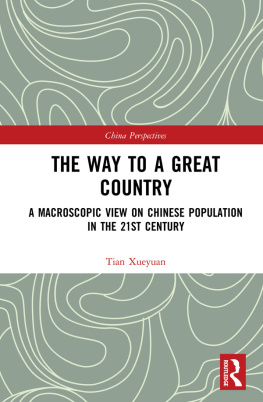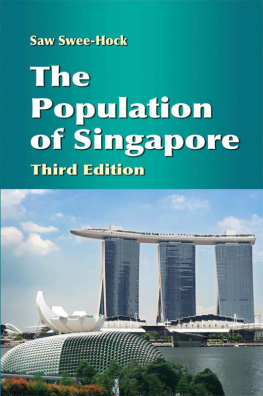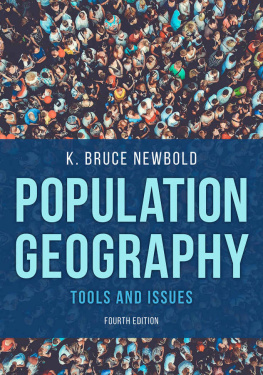CHINAS POPULATION: PROBLEMS, THOUGHTS AND POLICIES
To the memory of my mother Gao Yunzhen
and to my father Wang Huimin
First published 1999 by Ashgate Publishing
Reissued 2018 by Routledge
2 Park Square, Milton Park, Abingdon, Oxon, OX14 4RN
711 Third Avenue, New York, NY 10017
Routledge is an imprint of the Taylor & Francis Group, an informa business
Copyright Gabe T. Wang 1999
All rights reserved. No part of this book may be reprinted or reproduced or utilised in any form or by any electronic, mechanical, or other means, now known or hereafter invented, including photocopying and recording, or in any information storage or retrieval system, without permission in writing from the publishers.
Notice:
Product or corporate names may be trademarks or registered trademarks, and are used only for identification and explanation without intent to infringe.
Publishers Note
The publisher has gone to great lengths to ensure the quality of this reprint but points out that some imperfections in the original copies may be apparent.
Disclaimer
The publisher has made every effort to trace copyright holders and welcomes correspondence from those they have been unable to contact.
A Library of Congress record exists under LC control number: 98046435
ISBN 13: 978-1-138-61551-9 (hbk)
ISBN 13: 978-0-429-46306-8 (ebk)
Sometimes, differences, misunderstanding, or distrust between different nations tears the world apart. This book intends to promote mutual understanding by showing the differences. Although China has a long history and the largest population, mutual understanding between China and the rest of the world seems quite inadequate.
Chinas population problem and its efforts in controlling the growth of the huge population are fundamental to Chinas development; however, they are the most controversial in the world. Misunderstanding or lack of understanding often comes from a lack of information or a lack of accurate information. Therefore, this book provides its readers with more information about Chinas population and population control. The author tries hard to understand Chinas population problems, thoughts and policies, however, he has also realized that his information and understanding may be less than he expected.
In the highly diversified world today, mutual understanding, peace, and development are important. Therefore, it is the authors hope that this book will contribute to the mutual understanding of China and western nations, and to peace and development in the world.
With sincere appreciation, I would like to express my thanks to Professor Zhenzhen Zheng at Beijing University who has helped me considerably with this book. Several times, she has sent me books, journals, and conference papers all of which helped me in writing this book.
Ms. Chunxian Zhang in the Chinese Science Academy also deserves my thanks for her buying and sending me several newly published statistical books which I frequently cited.
Mrs. Susanne Lang did the final proofreading of the whole manuscript. I sincerely appreciate her careful and meticulous work. My sincere thanks also goes to the editors at Ashgate who carefully checked the format and consistency of the final manuscript.
Finally, I would like to express my appreciation to my wife Rong for her love, support, and help with the book. I would also like to express my appreciation for my son Yang who helped a lot by taking care of his sister. My adorable daughter Emily deserves thanks for being quiet most of the time when I was working on the manuscript.
Significance of Chinas Population
Chinas 1.22 billion population in 1996 was the largest population in the world, and it was more than one-fifth of the worlds 5.79 billion population (World Almanac, 1997). By the end of 1996, Chinas population was greater than the total population of all the developed countries in the world or about 42 times that of Canadas population in the same year. In other words, the population of China is about the same size as that of the Arab countries, Africa, and Latin America combined (Gugler, 1996). If we just take the sheer numbers into consideration, to understand people in China is equal to understanding people in Arab countries, African countries, and Latin American countries combined. It is important to understand the enormous population in China.
Recently, China has experienced dramatic demographic and economic changes which were unprecedented in the world during the twentieth century. These changes have brought about the demographic transition from a premodern to a modern regime in only four decades in China (Goldstein, 1996). These changes, in turn, have a fundamental impact on Chinas current development and will have a far-reaching effect on the nations future development.
Similarly, the current dramatic social and economic changes in China will definitely have a significant impact on the world politics, economy, environment, and development. If Chinas economy continues to develop rapidly, as it has in the past two decades, Chinas economy may become the most important economy in the world during the next century. As the former Chancellor of the Federal Republic of Germany, Helmut Schmidt points out that China will be the biggest economy of all the greatest market, the greatest importer, and the greatest exporter in the next century (1994).
The huge market of Chinas 1.2 billion population may stimulate the world economic development considerably. On the other hand, if China falls into chaos, as it did about half a century ago, the world will suffer its consequences. Either way, the world will be unavoidably affected by China as China will be inevitably affected by the world. China and the world are ever more closely related to each other. Therefore, the world needs to understand China.
In late 1970s, when China started its economic reform, the Chinese government had two strategic goals. The first was to quadruple its Gross National Product (GNP) and the second was to limit its population growth to within 1.2 billion during the last two decades of the twentieth century. Chinas economic reform and development have been welcomed and praised by many people in the world. However, Chinas efforts to control its population growth which is equally significant to China and the world has seldom been fully appreciated by the world.
Indicators of Chinas Economic and Social Development
Since the reform began in the late 1970s, China has maintained a rapid economic and social development. Between 1979 and 1994, Chinas annual average GNP increase rate was 9.8 percent (State Statistical Bureau of China, 1995). Between 1991 and 1996, the annual average increase rate was 11.2 percent. The individuals bank savings deposit in China also increased 183 times from 1978 to 1996 without considering inflation. Similarly, the export of the country also increased 75 times between 1978 and 1996 (State Statistical Bureau of China, 1997). It seems that Chinas ambitious economic development goal could be reached by the end of this century without any doubt (see .
However, its set goal of limiting the population within 1.2 billion by the end of the century has proved much more difficult to reach. The enormous population will definitely be more than 1.2 billion by the end of this century although the population growth has been considerably curbed. This may also indicate that the challenge posed by Chinas enormous population is greater than the challenge posed by its backward economy. Therefore, it is equally important, if not more important, for the world to understand Chinas population problems and her efforts in combating the problems.










